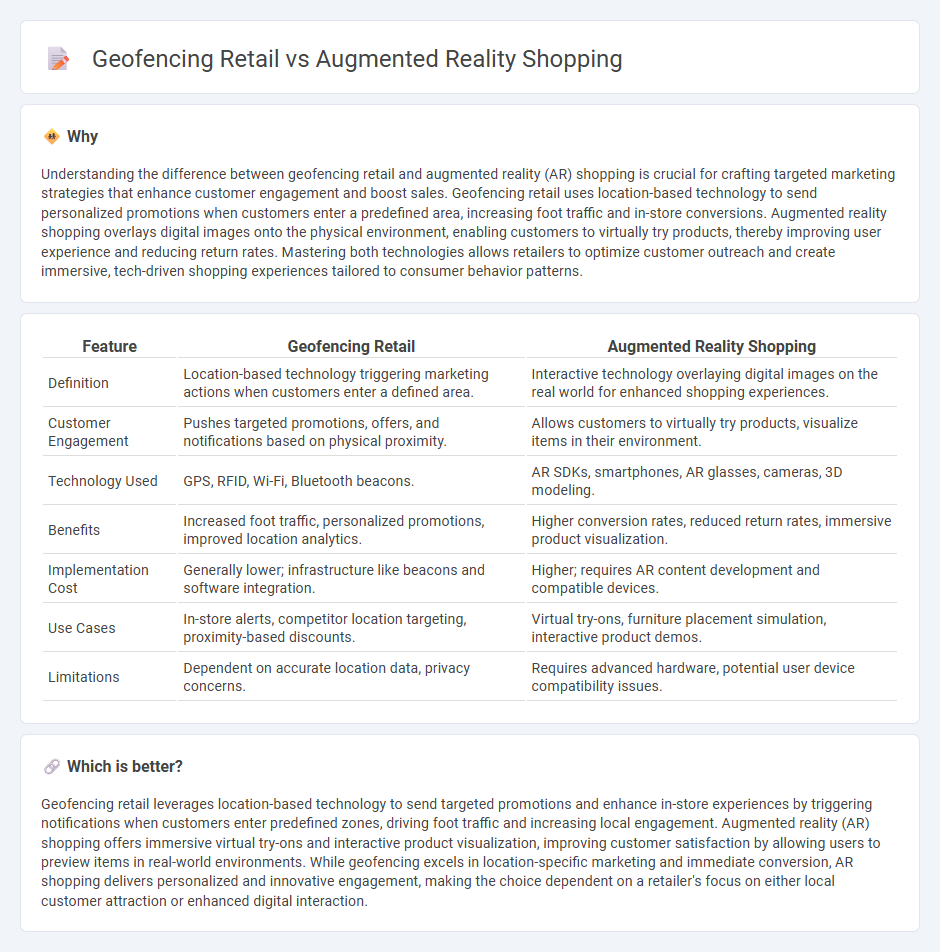
Geofencing retail leverages location-based technology to target customers with personalized promotions when they enter specific geographic boundaries, enhancing in-store engagement and driving foot traffic. Augmented reality shopping transforms the consumer experience by overlaying digital elements onto the physical environment, allowing shoppers to visualize products virtually before purchasing. Discover how integrating geofencing and augmented reality can revolutionize retail strategies and boost customer satisfaction.
Why it is important
Understanding the difference between geofencing retail and augmented reality (AR) shopping is crucial for crafting targeted marketing strategies that enhance customer engagement and boost sales. Geofencing retail uses location-based technology to send personalized promotions when customers enter a predefined area, increasing foot traffic and in-store conversions. Augmented reality shopping overlays digital images onto the physical environment, enabling customers to virtually try products, thereby improving user experience and reducing return rates. Mastering both technologies allows retailers to optimize customer outreach and create immersive, tech-driven shopping experiences tailored to consumer behavior patterns.
Comparison Table
| Feature | Geofencing Retail | Augmented Reality Shopping |
|---|---|---|
| Definition | Location-based technology triggering marketing actions when customers enter a defined area. | Interactive technology overlaying digital images on the real world for enhanced shopping experiences. |
| Customer Engagement | Pushes targeted promotions, offers, and notifications based on physical proximity. | Allows customers to virtually try products, visualize items in their environment. |
| Technology Used | GPS, RFID, Wi-Fi, Bluetooth beacons. | AR SDKs, smartphones, AR glasses, cameras, 3D modeling. |
| Benefits | Increased foot traffic, personalized promotions, improved location analytics. | Higher conversion rates, reduced return rates, immersive product visualization. |
| Implementation Cost | Generally lower; infrastructure like beacons and software integration. | Higher; requires AR content development and compatible devices. |
| Use Cases | In-store alerts, competitor location targeting, proximity-based discounts. | Virtual try-ons, furniture placement simulation, interactive product demos. |
| Limitations | Dependent on accurate location data, privacy concerns. | Requires advanced hardware, potential user device compatibility issues. |
Which is better?
Geofencing retail leverages location-based technology to send targeted promotions and enhance in-store experiences by triggering notifications when customers enter predefined zones, driving foot traffic and increasing local engagement. Augmented reality (AR) shopping offers immersive virtual try-ons and interactive product visualization, improving customer satisfaction by allowing users to preview items in real-world environments. While geofencing excels in location-specific marketing and immediate conversion, AR shopping delivers personalized and innovative engagement, making the choice dependent on a retailer's focus on either local customer attraction or enhanced digital interaction.
Connection
Geofencing in retail creates location-based triggers that activate augmented reality (AR) shopping experiences on customers' devices when they enter specific areas. This technology enhances customer engagement by overlaying digital information, promotions, or virtual product demos in real-time, driving foot traffic and increasing conversion rates. Integrating geofencing with AR transforms traditional retail spaces into interactive environments, merging physical and digital shopping seamlessly.
Key Terms
Virtual Try-On
Augmented reality shopping enhances customer experiences by enabling virtual try-on features that allow users to see how products such as clothing, accessories, or makeup look in real time. Geofencing retail leverages location-based technology to trigger personalized promotions or notifications when shoppers enter a designated area, enhancing engagement but lacking immersive visualization. Explore deeper insights into how virtual try-on technology transforms retail interactions and boosts conversion rates.
Location-Based Notifications
Augmented reality shopping enhances customer engagement by overlaying digital information onto physical products, allowing users to visualize items in their real environment, while geofencing retail leverages GPS or RFID technology to send targeted location-based notifications when shoppers enter a predefined area. Location-based notifications in geofencing drive immediate in-store traffic and provide personalized offers, optimizing conversion rates and improving customer experience. Explore how integrating augmented reality with geofencing can revolutionize retail marketing strategies and boost sales.
In-Store Navigation
Augmented reality shopping enhances in-store navigation by overlaying digital information onto the physical environment, enabling customers to locate products quickly and access personalized promotions through smartphone apps or AR glasses. Geofencing retail leverages location-based technology to trigger notifications, offers, or assistance when shoppers enter specific store zones, improving engagement and guiding customers efficiently. Explore how combining augmented reality with geofencing can revolutionize in-store navigation and elevate the retail experience.
Source and External Links
AR Shopping: Top Trends and Apps for the Future (2024) - Shopify - Augmented reality (AR) shopping lets customers virtually try on and test products via devices like smartphones or VR headsets, enhancing immersive pre-purchase experiences for items such as clothing or furniture.
Top 5 Augmented Reality Apps that Created Immersive Shopping ... - AR apps provide shoppers a "try-before-you-buy" experience by visualizing products in their real environment, helping to make more informed purchasing decisions.
Augmented Reality is the Future of Online Shopping - Time Magazine - Brands like Nike integrate AR into social media platforms to allow consumers to customize and virtually try on products, driving engagement and sales among younger audiences.
 dowidth.com
dowidth.com